
The Sanctuary of Saint Michael the Archangel is a Roman Catholic shrine on Mount Gargano, Italy, part of the commune of Monte Sant'Angelo, in the province of Foggia, northern Apulia. It has the dignity of a minor basilica.
San Lorenzo Maggiore is a town and comune in the province of Benevento, in the Campania region of southern Italy. It is a member of the Titerno Local Action Group.

Maddaloni is a town and comune of Campania, Italy, in the province of Caserta, about 5 kilometres (3 mi) southeast of Caserta, with stations on the railways from Caserta to Benevento and from Caserta to Naples.
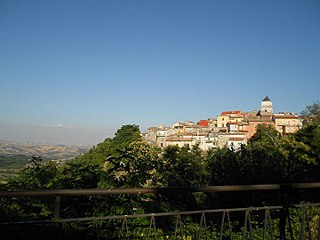
Guardia Lombardi, known as La Uàrdia in the Irpinian dialect, is a small town and comune in the Province of Avellino in Campania, Italy. At an elevation of 998 metres (3,274 ft), it is located in Irpinia in the Apennine Mountains of Southern Italy. It has experienced a number of major earthquakes throughout its history that have devastated the town, and is considered within zone 1 of the Protezione Civile's seismic classification index, indicating very high seismicity.
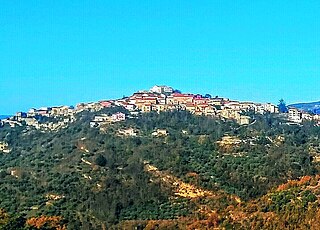
Montecalvo Irpino is a town and comune in the province of Avellino, Campania, southern Italy.

Montesarchio is a comune in the Province of Benevento, Campania, Southern Italy. It is located 18 kilometres southwest of Benevento in the Valle Caudina at the foot of Monte Taburno. The commune was granted the official status of city (città) by a presidential decree of 31 July 1977. In 2020, it had a population of 13,226.
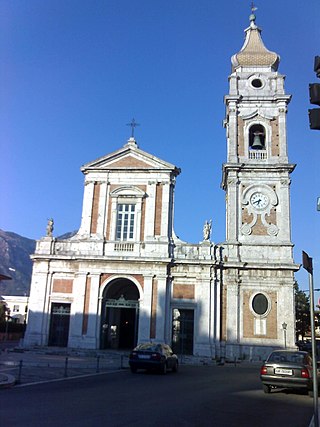
Airola is a comune (municipality) in the Province of Benevento in the Italian region Campania, located about 35 km northeast of Naples and about 20 km southwest of Benevento in the Valle Caudina, facing the Monte Taburno. Nearby is the confluence of the Tesa and Faenza streams into the Isclero River. Airola's territory is also crossed by the Acquedotto Carolino, carrying waters to the Caserta Palace.
Apollosa is a comune (municipality) in the Province of Benevento in the Italian region Campania, located about 50 km northeast of Naples and about 8 km southwest of Benevento.

Arpaia is a town, comune (municipality) and former episcopal see in the Province of Benevento in the southern Italian region Campania, located about 35 km northeast of Naples and about 25 km southwest of Benevento.

Bucciano is a comune (municipality) in the Province of Benevento in the Italian region of Campania, located about 40 km northeast of Naples and about 20 km southwest of Benevento on the southern slopes of the Monte Taburno.
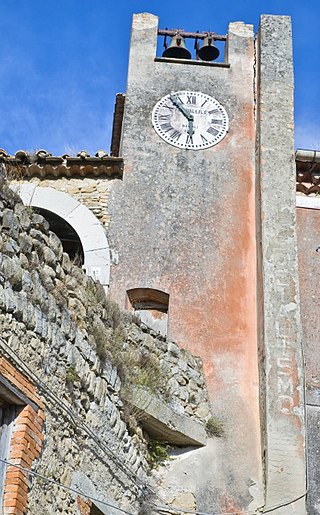
Castelpoto is a comune (municipality) in the Province of Benevento in the Italian region Campania, located about 50 km northeast of Naples and about 7 km west of Benevento.
Cautano is a comune (municipality) constituted from two countries, Cautano and Cacciano, in the Province of Benevento in the Italian region Campania, located about 75 km northeast of Naples and about 13 km west of Benevento and about 13 km north of Montesarchio..

Moiano is a comune (municipality) in the Province of Benevento in the Italian region Campania, located about 40 kilometres (25 mi) northeast of Naples and about 20 kilometres (12 mi) southwest of Benevento on the western slope of the Monte Taburno, on the river Isclero.

Vitulano is a comune (municipality) in the Province of Benevento in the Italian region Campania, located about 50 km northeast of Naples and about 12 km northwest of Benevento.

Taburno Camposauro is a massif located in the Apennines, to the west of Benevento, in the Campania region of Southern Italy. Its highest peak is the Taburno, at 1,393 m. It is composed of two groups of calcareous mountains separated by a plain. The fauna is affected by human activities, but the birdlife is very diverse. Several historical structures, mainly religious, are located on the massif. A DOC wine is produced in the area.

The Pontifical Shrine of the Blessed Virgin of the Rosary of Pompei is a Roman Catholic cathedral, Marian pontifical shrine and minor basilica commissioned by Bartolo Longo, located in Pompei, Italy. It is the see of the Territorial Prelature of Pompei.
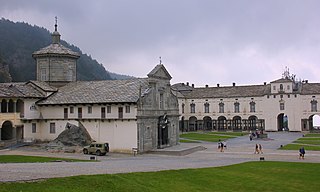
The Sanctuary of Oropa is a group of Roman Catholic buildings and structures in Oropa, frazione of the municipality of Biella, Italy. It is located at a height of 1,159 metres in a small valley of the Alpi Biellesi.

The Sanctuary of the Most Holy Mary of the Height is a place of Marian devotion, located on the top of Mount Bonifato, in Alcamo in the province of Trapani, Italy.

Santa Maria in Gruptis is a former abbey located in the comune of Vitulano, in the Campania region of Southern Italy. Founded in the 10th century and used by several monastic orders, it was deconsecrated in 1705, and is currently in ruins.

The Sanctuary of San Gerardo Maiella, co-located with the Basilica of Santa Maria Mater Domini, is a Roman Catholic church and monastery complex in Materdomini, a frazione of Caposele in the Province of Avellino and the Campania region of Italy. The newer sanctuary is a shrine to Saint Gerard Majella, while the older church is dedicated in the name of Santa Maria Mater Domini and holds the ecclesiastical rank of minor basilica.






















